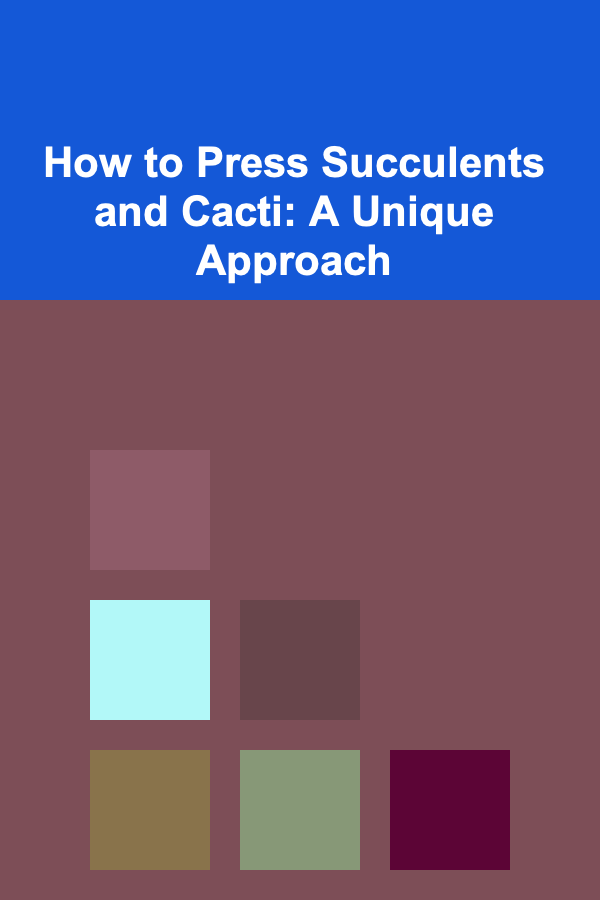
How to Press Succulents and Cacti: A Unique Approach
ebook include PDF & Audio bundle (Micro Guide)
$12.99$6.99
Limited Time Offer! Order within the next:

Pressing flowers and plants is an age-old craft that has fascinated enthusiasts for centuries. The practice of preserving the beauty of nature through pressing has evolved into a respected art form. Succulents and cacti, with their distinct shapes, textures, and colors, offer a unique challenge and opportunity for plant pressing. Pressing these plants requires patience, technique, and an understanding of their particular characteristics. Whether you're looking to incorporate pressed succulents and cacti into art, home decor, or botanical studies, this guide provides a comprehensive approach to pressing these resilient plants.
Why Press Succulents and Cacti?
Succulents and cacti are known for their ability to thrive in arid conditions, making them incredibly versatile in both nature and art. Pressing them not only captures their beauty but also preserves the rich textures and details that distinguish them from other plants. Unlike traditional flowers that are soft and pliable, succulents and cacti have thicker leaves, stems, and often waxy coatings that provide both challenges and advantages when pressed.
Benefits of Pressing Succulents and Cacti:
- Unique Texture Preservation: Succulents and cacti have thick, fleshy leaves that hold their structure when pressed properly.
- Long-Term Preservation: Due to their resilient nature, succulents and cacti can remain vibrant and undistorted for years if pressed correctly.
- Versatility in Art: Pressed succulents and cacti are perfect for crafting art, greeting cards, scrapbooking, and interior design.
- Educational Value: Pressing these plants is an excellent way to learn about their morphology, providing valuable insights into their growth patterns and adaptations.
Despite their apparent toughness, pressing succulents and cacti can be tricky, and mastering the technique will allow you to create stunning pieces of art that showcase their beauty and intricate details.
Choosing the Right Succulent or Cactus for Pressing
Not all succulents and cacti are ideal for pressing. When selecting the plants for pressing, it's essential to consider the thickness, shape, and moisture content of the leaves. Some plants are more forgiving than others, while some require extra care. Here's how to choose the best candidates for pressing:
Ideal Succulent and Cactus Varieties:
- Echeveria: Known for their rosette shape, these succulents hold their structure well when pressed.
- Sedum: The flat leaves of sedum succulents are perfect for pressing, and their colors often intensify after being pressed.
- Aloe Vera: Aloe leaves are thick and fleshy, making them ideal for pressing. However, they may require extra attention to prevent wilting.
- Opuntia (Prickly Pear Cactus): The flat pads of prickly pear cacti are excellent for pressing. However, you'll need to carefully remove the spines before pressing.
- Crassula: Another rosette-forming succulent that presses well and retains its structure.
Avoid:
- Too Thick or Woody Leaves: Some succulents, like certain agave species, may have leaves that are too thick or woody to press effectively.
- Spiny Cacti: Some cacti, especially those with prominent spines, can be difficult to press properly. While their spines can be removed, they still require special care to avoid damaging the plant.
Preparing Your Plants for Pressing
Before you begin pressing, it's essential to prepare the succulents and cacti properly. This involves cleaning, trimming, and sometimes drying the plants to ensure they retain their shape and color during the pressing process.
Steps to Prepare Succulents and Cacti:
- Harvesting: Gently cut the leaves or pads from the succulent or cactus using a clean, sharp knife or scissors. For cacti, use tongs or wear gloves to avoid pricking yourself with the spines.
- Cleaning: If the plants have dirt or residue on them, gently rinse them with water. Allow them to air dry thoroughly before proceeding.
- Trimming: Trim away any damaged or overly thick sections of the plant. For succulents, cutting the leaves into smaller sections may help ensure they press more evenly.
- Drying (Optional): If you're working with particularly thick or fleshy plants, you may want to dry them slightly before pressing. This helps reduce the moisture content, which can otherwise result in mold or mildew during the pressing process.
The Importance of Moisture Control:
One of the challenges of pressing succulents and cacti is their high moisture content. While some plants, such as aloe vera, are naturally quite fleshy and moist, they can become overly soggy when pressed. This excess moisture can cause them to lose their shape, become slimy, or even rot.
To prevent these issues, it's essential to ensure that the plants are relatively dry before pressing. This is especially important for cactus pads, which are known for holding water within their flesh.
The Pressing Process: Step-by-Step Guide
Once your succulents and cacti are properly prepared, it's time to press them. Pressing involves flattening the plant between two surfaces while ensuring that it retains its shape and texture. There are different methods to press these plants, but the most effective ones combine traditional techniques with modern tools.
Method 1: Using a Plant Press
A plant press is a tool designed specifically for pressing plants and flowers. It typically consists of two wooden boards with adjustable bolts or screws to apply pressure to the plant material.
Step-by-Step Using a Plant Press:
- Place the Plant: Lay the succulent or cactus flat on a sheet of parchment paper, ensuring that it is positioned in the way you want it to appear in the finished product.
- Layering: Place another sheet of parchment paper on top of the plant. Then, place a sheet of newspaper or absorbent paper on top of that. This helps absorb moisture as the plant dries.
- Apply Pressure: Tighten the bolts or screws on the plant press, applying firm but even pressure to the plant. Make sure the plant is pressed evenly to avoid distortion.
- Drying Time: Allow the plant to press for 2-3 weeks. Check it regularly for signs of moisture buildup or mildew. If necessary, replace the absorbent paper to keep the plant dry.
Method 2: Using Books or Heavy Objects
If you don't have a plant press, you can achieve a similar effect by using heavy books or other weighted objects.
Step-by-Step Using Books:
- Prepare the Plant: Lay the succulent or cactus between two sheets of parchment paper.
- Place Between Pages: Open a large book (preferably a thick one with heavy pages) and place the plant inside. If necessary, add additional sheets of paper to absorb moisture.
- Add Weight: Close the book and place additional weight on top to apply pressure. You can use other books, boxes, or even bricks for added weight.
- Drying Time: Leave the plant pressed for about 2-3 weeks, checking occasionally to ensure it is drying properly.
Method 3: Using Silica Gel
For a quicker drying process that retains more of the plant's color and texture, you can use silica gel. This method is especially useful for preserving succulents that are more delicate or contain a high level of moisture.
Step-by-Step Using Silica Gel:
- Prepare the Container: Choose a shallow container and fill it with a layer of silica gel.
- Position the Plant: Place the succulent or cactus gently onto the silica gel, ensuring it is flat and properly positioned.
- Cover with Silica Gel: Carefully pour more silica gel over the plant until it is completely covered. Be cautious not to damage the plant while handling it.
- Drying Time: Leave the plant in the silica gel for about 2-4 days. Afterward, carefully remove it from the gel. Silica gel will preserve both the shape and color of the plant.
Using Pressed Succulents and Cacti
Once your succulents and cacti are pressed and dried, you can use them in a variety of creative and functional ways. Here are some ideas for incorporating pressed plants into your art:
Art and Crafting:
- Framed Art: Arrange the pressed plants on a piece of paper or canvas, and frame it as a botanical print. The unique shapes and textures of succulents and cacti make them ideal for framing.
- Greeting Cards: Create one-of-a-kind greeting cards by adhering pressed plants to the surface of blank cards. Succulent and cactus designs are particularly popular for modern, minimalist cards.
- Scrapbooking: Use pressed succulents and cacti in scrapbooks or journals to add a natural, textured element to your pages.
Home Decor:
- Wall Hangings: Pressed plants can be arranged into beautiful wall hangings, either framed or displayed in shadow boxes.
- Coasters or Table Decor: Incorporate pressed succulents into resin coasters or tabletop art pieces for a contemporary, natural look.
Educational Uses:
- Botanical Studies: Pressed succulents and cacti can be used in educational contexts to study their morphology and structure. They serve as excellent specimens for teaching about plant biology.
Caring for Pressed Succulents and Cacti
To ensure your pressed plants last as long as possible, it's important to care for them properly.
Tips for Preserving Pressed Plants:
- Avoid Direct Sunlight: Keep pressed plants away from direct sunlight, as prolonged exposure can cause fading.
- Keep Dry: Store pressed plants in a dry environment to avoid mold growth. If the plants start to feel moist, remove them from their frame or container to air dry.
- Handle Gently: Pressed succulents and cacti are fragile. Handle them with care to avoid crushing or tearing.
Conclusion
Pressing succulents and cacti offers a unique way to preserve their natural beauty while showcasing their intricate textures and vibrant colors. With the right techniques and tools, you can create stunning works of art that highlight the beauty of these resilient plants. Whether you're a hobbyist looking to add a personal touch to your home decor or a botanist documenting plant species, pressing succulents and cacti opens up a world of creative possibilities. Embrace this technique and explore the fascinating world of pressed plants.
Reading More From Our Other Websites
- [Biking 101] Road Bike vs. Mountain Bike: Which One is Right for You?
- [Home Renovating 101] How to Plan Your Dream Home Renovation Ideas from Start to Finish
- [Home Storage Solution 101] How to Organize Pet Supplies with Storage Solutions That Work
- [Home Space Saving 101] How to Create Hidden Storage Under Your Stairs
- [Personal Care Tips 101] How to Pick a Body Wash with the Best Ingredients for Your Skin
- [Simple Life Tip 101] Best Simple‑Life Meditation Practices for Beginners with a Busy Schedule
- [Personal Care Tips 101] How to Incorporate Cuticle Oil Into Your Nail Care Routine for Better Results
- [Weaving Tip 101] From Thread to Tapestry: Beginner's Guide to Hand Weaving Techniques
- [Home Security 101] How to Make Your Home Less of a Target with Simple Security Hacks
- [Survival Kit 101] Survival Kit: Essential Items for Every Emergency Situation

How to Communicate Employee Benefits Effectively Before Enrollment
Read More
How to Create a Document Organization System That Works for You
Read More
How to Master Frugal Meal Prep for the Week
Read More
How to Use Real Estate as a Long-Term Investment Strategy
Read More
How To Manage Your Investments Through Different Economic Cycles
Read More
Discovering Advances in Post-Traumatic Stress Disorder
Read MoreOther Products

How to Communicate Employee Benefits Effectively Before Enrollment
Read More
How to Create a Document Organization System That Works for You
Read More
How to Master Frugal Meal Prep for the Week
Read More
How to Use Real Estate as a Long-Term Investment Strategy
Read More
How To Manage Your Investments Through Different Economic Cycles
Read More